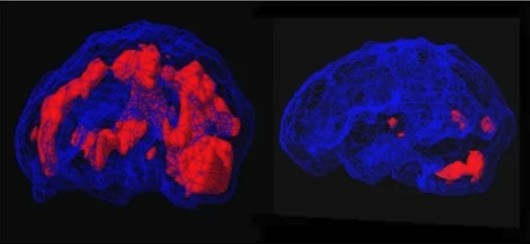The image shown above is of two brain scans of a woman with PTSD. The red indicates over-activity in the brain. The brain scan on the left is prior to exposure to EMDR. The scan on the right is the same woman after four 90-minute EMDR therapy sessions.
What is EMDR Therapy?
EMDR is defined as Eye Movement Desensitization and Reprocessing. It is an evidence-based therapy that helps people heal from trauma, anxiety, depression, and other distressing life experiences, past or present.
How Does EMDR Therapy Work?
EMDR Institute describes EMDR as a structured therapy that encourages the patient to focus briefly on the trauma memory while simultaneously experiencing bilateral stimulation (typically eye movements), which is associated with a reduction in the vividness and emotion associated with the trauma memories. EMDR therapy is an extensively researched, effective psychotherapy method proven to help people recover from trauma and PTSD symptoms.
Ongoing research supports positive clinical outcomes showing EMDR therapy as a helpful treatment for disorders such as anxiety, depression, OCD, chronic pain, addictions, and other distressing life experiences (Maxfield, 2019). EMDR therapy has even been superior to Prozac in trauma treatment (Van der Kolk et al., 2007).
How Does EMDR Therapy Effect The Brain?
Healing with EMDR happens through our brain. Our brains have a natural way of recovering from traumatic memories and events. This process involves communication between the amygdala (the alarm signal for stressful events), the hippocampus (where safety and danger memories are created and stored), and the prefrontal cortex (which controls behavior and emotion).
Some events are so upsetting that the normal communication between these areas becomes blocked and cannot be processed without guidance. This stress response is part of our natural fight, flight or freeze response. When distress from a disturbing event still lingers, the upsetting images, thoughts, and emotions may create feelings of overwhelm. EMDR therapy helps the brain process these memories and allows healing to resume.
How is EMDR Different From Other Therapies?
Per EMDR Institute, EMDR therapy does not require talking in detail about the distressing issue or traumatic experiences. Rather than focusing on changing the emotions, thoughts, or behaviors resulting from the distressing issue, EMDR allows the brain to resume its natural healing process. EMDR is designed to activate this natural healing process in the brain through alternating eye movements, sounds, or taps. For many clients, EMDR therapy can be completed in fewer sessions than a normal psychotherapy session.
Who Can Benefit From EMDR Therapy?
EMDR therapy helps children and adults of all ages. We use EMDR with a wide range of challenges:
- Anxiety, panic attacks, and phobias
- Chronic Illness and medical issues
- Depression
- Dissociative disorders
- Grief and loss
- Pain
- Performance anxiety
- Personality disorders
- PTSD and other trauma and stress-related issues
- Sexual assault
- Sleep disturbance
- Violence and abuse
“At the end of therapy, success would be defined by a person who can love, bond, feel secure, and find joy in living.”
Francine Shapiro, Founder of EMDR
